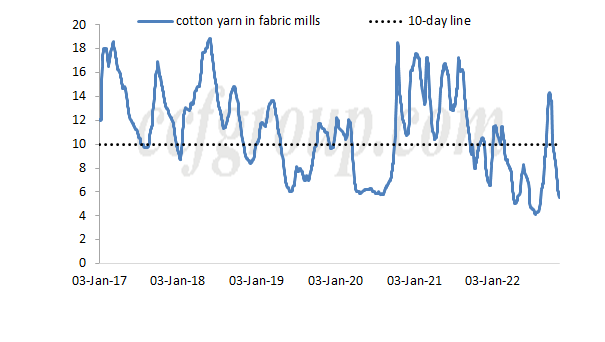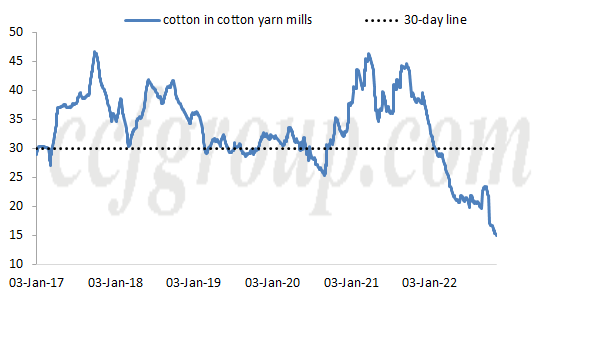Low feedstock inventory in yarn and fabric mills amid volatile cotton price
Now it is the arriving season for new cotton. More than 90% Chinese cottons were produced in Xinjiang, but epidemic slowed down cotton procurement, processing, inspection and transportation obviously. Chinese cotton supply was relatively tight, and cotton procurement as well as sold prices are in great mix. The mixed feedstock prices diverged cotton usage cost among cotton yarn mills greatly, but the overall spot profit was mostly at loss. When Chinese cotton tight supply condition will get released becomes the focus in the market, and the severer epidemic in China made the released time of epidemic confused. There were 1,294 new local cases and 6,682 asymptomatic cases yesterday. Scattered spread of epidemic made the sales of enterprises be influenced, and the flow efficiency reduced largely among regions.
The epidemic in Guangzhou, Xinjiang, Zhengzhou and Nantong affected the operating rate of enterprises in different regions. The operating rate of both cotton yarn mills and fabric mills reduced because of epidemic control and the accumulated inventory due to the lack of orders. The operating rate of cotton yarn mills was 45.7% till yesterday, and moved down around 10% compared to that in end-September. The operating rate of cotton fabric mills slipped by about 7%. The demand didn’t have obvious support point in November, and the operating rate of yarn and fabric mills is expected to reduce further. The chart below is feedstock inventory condition.


It can be seen from chart that cotton inventory in cotton yarn mills has already been at low level, and could only last for half a month. However, the normal averaged value is around 30days. In 2021/22 season, cotton inventory of cotton yarn mills narrowed constantly, and it gradually reduced from 46days to 15days. Downstream fabric mills kept low cotton yarn inventory, and more fabric mills produced order by order. There will be restocking demand in the future, and downstream demand will be the key factor to inhibit replenishment volume. Both domestic and foreign sales lacked firm support, so yarn and fabric mills mostly stocked up with cautiousness. New Year Eve this year is on January 21th, which is two months from now. According to customs in previous year, enterprises will be on holiday successively after January 1st. However, the holiday of enterprises this year may be earlier in the second half of December. If there is expectation on the market, it will be some restocking in the second half of December mainly because the feedstock stockings were scarce amid the moving down of prices this year. The market tends to be expected after Spring Festival. Thus, mills will stock up as they need the stocking of feedstock for production. If there is restocking market before Spring Festival, the production may focus on replenishment with scattered volume.
- Top keywords
- Cotton Price
- Cotton Futures Price
- Cotton Futures
- CZCE
- PTA Futures Price
- Chemical Fiber
- Polyester Prices
- Wool price
- PTA Futures
- Shengze Silk
- China
- Yarn Price
- price
- China Textile City
- Fibre Price
- Benzene Price
- Cotton
- Index
- Cotton Index
- PTA
- fabric price
- NYMEX
- Top 10
- textile industry
- Spot Cotton
- Cotton Yarn
- Polyester Price
- Futures
- PTA Price
- cotton yarn price

